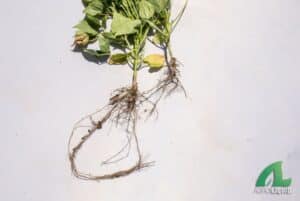
To get the best yield, you need to plan ahead. Calcium is a secondary nutrient that crops – especially soybeans – need the right amount of to thrive.
Calcium
Calcium is needed in large amounts for the formation of cell walls and cell membranes, and it also plays a role in soil structure. Since it’s immobile in soil and plant tissues, crops need a continuous supply present.
What does immobile mean? Calcium is only xylem mobile, meaning it can only move up the plant, and once it’s there, it won’t move to developing tissues. As a result, growing points can be affected once the soil reserves are depleted.
Due to calcium’s low mobility, there is a deficiency even in soils with high calcium levels. Deficiencies include growing point death, tip burn, and shedding of blossoms and buds.
Studies show that adding calcium to a foliar nutritional program will help, and due to its limited movement in the plant, adding it during critical development stages improves the overall plant health.
Soybeans
According to the U.S. Department of Agriculture, soybean growers are going to plant 87.5 million acres in 2023.
One of those growers is Kevin Matthews, a farmer in North Carolina. Matthews works in partnership with XtremeAg.farm and conducts research trials for AgroLiquid on his farm.
Matthews was recently featured on the XtremeAg.farm podcast speaking about his plot trials with moderator Damian Mason and AgroLiquid agronomist Stephanie Zelinko.
“We’re focusing more on adding calcium to our [in-furrow] and our foliar treatments,” Matthews said. “For years we focused on P (phosphorus) and K (potassium), and pH, and there’s a lot more to it now. We allocated that money around to get these specialty products. That’s what it’s all about. We’ll be able to prove it with these plot sizes – five acres.”
Stephanie Zelinko agreed, talking about the educational aspect of farming.
“The soil test is going to be the first thing make the grower successful,” Zelinko added. “If there’s something wrong with the soil…that’s what we want to address. We’re looking where that limiting factor might be, and where we can encourage them to spend dollars in right place to get the right results. For Kevin, calcium and potassium are the two nutrients we’re focusing in on for him this year.”
Hear about Kevin Matthew’s plot trials.
Testing
Making sure fertilizers are compatible is always a concern. AgroLiquid conducted a test to check yields after adding a phosphorus-compatible calcium source to a soybean planter fertilizer program.
LiberateCa is a 2% calcium product that safely mixes with fertilizers containing phosphorus. AgroLiquid conducted the experiment at the North Central Research Station in Michigan.
The average percent base saturation of calcium was at 68%. With a pH of 7.7 and good potassium level at 4.5% base saturation, the biggest concern was a slightly elevated magnesium base saturation. To help adjust those levels in a seed zone, and provide extra calcium, we applied 2 qt/A of LiberateCa in-furrow with a planter program of 5 gal/A Sure-K and 2 qt/A Micro 500.
As a result, the standard program of 5 gal/A of Sure-K with 2 qt/A Micro 500, based off of soil test, increased soybean yield over the untreated check by 5.5 bu/A.
The addition of LiberateCa to the AgroLiquid program further increased soybean yield by over 4 bu/A.
Get the details of the study.
Results
Testing, researching, and experimenting takes years, and the benefit is higher yields.
“It took [AgroLiquid] a couple of years to learn our soil, rainfall, and environment to see how different products react,” Matthews said. It’s a more senior year with them, and I’m looking for some bigger expectations. It’s going to be fun to see what we can push the limits to.”
AgroLiquid calcium-containing products
Liberate Ca™, microLink™ Calcium, Micro 1000
See the 2020 calcium and soybean study.

